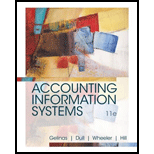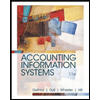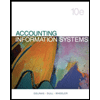
Accounting Information Systems
11th Edition
ISBN: 9781337552127
Author: Ulric J. Gelinas, Richard B. Dull, Patrick Wheeler, Mary Callahan Hill
Publisher: Cengage Learning
expand_more
expand_more
format_list_bulleted
Question
Chapter 5, Problem 2SP
Summary Introduction
To explain: The relationship and cardinalities of the two diagrams.
Introduction:
Database management systems (DBMS):
It is computer software for creating and managing databases. The DBMS provides a way for the users to create, update, retrieve and manage the data present in the database. It also supports the administration and use of the database on different platforms.
Expert Solution & Answer
Want to see the full answer?
Check out a sample textbook solution
Students have asked these similar questions
Which of the following activities would use number of customer orders as an activity base?
A.
Order shipping
B.
Invoicing & collecting
C.
Customer return processing
D.
Both A & B
OLTP VERSUS OLAP SERVERS
For each of the following processes, state whether OLTP or OLAP is appropriate, and why.
An order entry system that retrieves customer information, invoice information, and inventory information for local sales.
An order entry system that retrieves customer information, invoice information, inventory information, and several years of sales information about both the customer and the inventory items. An order entry system that retrieves customer information, invoice information, inventory information, and information to compare the current sale to sales across several geographic regions.
An order entry system that retrieves customer information, invoice information, inventory information, and accounts receivable information for sales within one marketing region.
An insurance company requires a system that will allow it to determine total claims by region, whether a relationship exists between claims and meteorological phenomena, and why one region seems to be…
Given the following business rules, construct an ER diagram so each rule is captured for the database. Presume each rule is to be treated individually. Construct an ER diagram for each rule.a. A retail sales company prepares sales orders for its customers’ purchases. A customer can make many purchases, but a sales order is written for a single customer.b. A retail sales company orders inventory using a purchase order. An inventory item may be ordered many times, and a purchase order may be created for more than one inventory item.c. A company that sells antique cars prepares a sales order for each car sold. The inventory for this company consists of unique automobiles, and only one of these automobiles may be listed on a sales order.d. A grocery store identifies returning customers via a plastic card that the clerk scans at the time of each purchase. The purpose of this card is to track inventory and to maintain a database of customers and their purchases. Obviously, a customer may…
Chapter 5 Solutions
Accounting Information Systems
Ch. 5 - Prob. 1RQCh. 5 - Prob. 2RQCh. 5 - Prob. 3RQCh. 5 - What are the most important limitations of the...Ch. 5 - Prob. 5RQCh. 5 - Prob. 6RQCh. 5 - Prob. 7RQCh. 5 - Prob. 8RQCh. 5 - Prob. 9RQCh. 5 - Prob. 10RQ
Ch. 5 - Prob. 11RQCh. 5 - Prob. 12RQCh. 5 - Prob. 13RQCh. 5 - What is a partial dependency?Ch. 5 - Prob. 15RQCh. 5 - Prob. 16RQCh. 5 - Prob. 17RQCh. 5 - What factors distinguish DSS from EIS?Ch. 5 - Describe the basic differences between ES and NN.Ch. 5 - What role do intelligent agents play in the...Ch. 5 - Why have knowledge management systems become so...Ch. 5 - Prob. 22RQCh. 5 - Prob. 23RQCh. 5 - Prob. 1DQCh. 5 - How has the technological availability and...Ch. 5 - Prob. 3DQCh. 5 - Prob. 4DQCh. 5 - What are the differences between a logical view...Ch. 5 - Prob. 6DQCh. 5 - Prob. 7DQCh. 5 - Prob. 8DQCh. 5 - Prob. 9DQCh. 5 - Prob. 10DQCh. 5 - Prob. 11DQCh. 5 - Prob. 12DQCh. 5 - Prob. 1SPCh. 5 - Prob. 2SPCh. 5 - Prob. 7PCh. 5 - Prob. 12PCh. 5 - Use the Internet to research knowledge management...
Knowledge Booster
Similar questions
- Sunset Graphics often buys inventory after receiving a sales order from the customer. Suppose you are asked to prepare one UML class diagram that combines both the sales and collection process and the purchases and payments process. What would be shared among those processes? What would be unique to each process? Why?arrow_forwardWhich files are often found in a sales order module as opposed to an account receivable (customer) module, on average? What is the source of this discrepancy?arrow_forward1. A clerk in the sales department receives a hard-copy customer order by mail and manually prepares four hard copies of a sales order. This is a typical event in the Group of answer choices b. Expenditure cycle d. Costing cycle a. Revenue cycle c. Conversion cycle 2. Which of these is not a true statement relating to manual and electronic accounting systems? Group of answer choices a. Large businesses integrate their accounting software with their overall computerised information system. b. The accounting principles underlying manual and electronic systems are fundamentally different. c. Computerised systems normally provide more reports, providing greater information to users, than manual systems. d. Most entities today use computerised accounting systems. 3. All of the following are advantages of using subsidiary ledgers, except Group of answer choices a. they make possible a division of labour b. they show all the transactions affecting customers and creditors.…arrow_forward
arrow_back_ios
arrow_forward_ios
Recommended textbooks for you
 Accounting Information SystemsFinanceISBN:9781337552127Author:Ulric J. Gelinas, Richard B. Dull, Patrick Wheeler, Mary Callahan HillPublisher:Cengage Learning
Accounting Information SystemsFinanceISBN:9781337552127Author:Ulric J. Gelinas, Richard B. Dull, Patrick Wheeler, Mary Callahan HillPublisher:Cengage Learning Pkg Acc Infor Systems MS VISIO CDFinanceISBN:9781133935940Author:Ulric J. GelinasPublisher:CENGAGE L
Pkg Acc Infor Systems MS VISIO CDFinanceISBN:9781133935940Author:Ulric J. GelinasPublisher:CENGAGE L Accounting Information SystemsAccountingISBN:9781337619202Author:Hall, James A.Publisher:Cengage Learning,
Accounting Information SystemsAccountingISBN:9781337619202Author:Hall, James A.Publisher:Cengage Learning,

Accounting Information Systems
Finance
ISBN:9781337552127
Author:Ulric J. Gelinas, Richard B. Dull, Patrick Wheeler, Mary Callahan Hill
Publisher:Cengage Learning

Pkg Acc Infor Systems MS VISIO CD
Finance
ISBN:9781133935940
Author:Ulric J. Gelinas
Publisher:CENGAGE L

Accounting Information Systems
Accounting
ISBN:9781337619202
Author:Hall, James A.
Publisher:Cengage Learning,